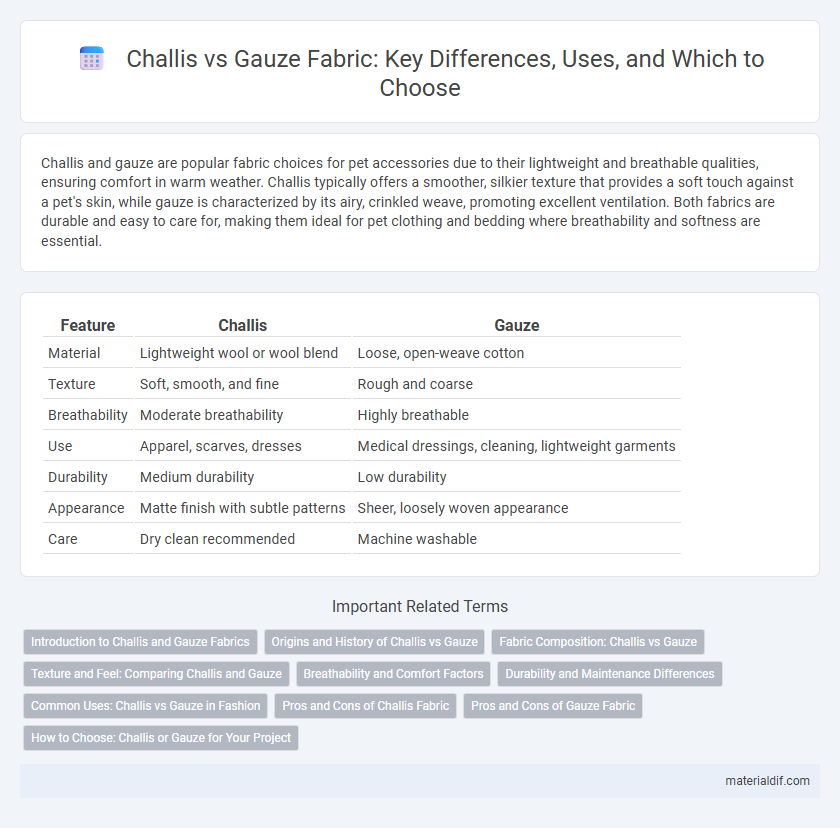Challis and gauze are popular fabric choices for pet accessories due to their lightweight and breathable qualities, ensuring comfort in warm weather. Challis typically offers a smoother, silkier texture that provides a soft touch against a pet's skin, while gauze is characterized by its airy, crinkled weave, promoting excellent ventilation. Both fabrics are durable and easy to care for, making them ideal for pet clothing and bedding where breathability and softness are essential.
Table of Comparison
| Feature | Challis | Gauze |
|---|---|---|
| Material | Lightweight wool or wool blend | Loose, open-weave cotton |
| Texture | Soft, smooth, and fine | Rough and coarse |
| Breathability | Moderate breathability | Highly breathable |
| Use | Apparel, scarves, dresses | Medical dressings, cleaning, lightweight garments |
| Durability | Medium durability | Low durability |
| Appearance | Matte finish with subtle patterns | Sheer, loosely woven appearance |
| Care | Dry clean recommended | Machine washable |
Introduction to Challis and Gauze Fabrics
Challis fabric is a soft, lightweight, and breathable woven material typically made from wool, cotton, or rayon, prized for its smooth texture and draping qualities. Gauze fabric is a loosely woven, thin, and airy textile often composed of cotton or silk, known for its sheer appearance and high breathability. Both fabrics serve distinct purposes in fashion and home textiles, with challis favored for comfortable apparel and gauze commonly used for medical dressings and lightweight garments.
Origins and History of Challis vs Gauze
Challis fabric originated in Norwich, England, during the early 19th century, known for its lightweight, soft, and slightly brushed finish, primarily used in women's dresses and scarves. Gauze has ancient roots, dating back to the Middle East and Egypt, recognized for its loose, open weave and sheer texture, traditionally employed in medical bandages and lightweight clothing. Both fabrics evolved from distinct cultural and functional needs, with challis emphasizing comfort and drape, while gauze focused on breathability and translucence.
Fabric Composition: Challis vs Gauze
Challis fabric is typically made from lightweight fibers such as rayon, cotton, or wool, offering a smooth, soft texture with a tightly woven structure. Gauze fabric consists of a loose, open weave primarily made from cotton or synthetic fibers, providing breathability and a sheer appearance. The contrasting fabric compositions of Challis and Gauze directly influence their texture, durability, and ideal applications in garments and textiles.
Texture and Feel: Comparing Challis and Gauze
Challis fabric features a smooth, lightweight texture with a soft, silky feel, ideal for draping and comfort. Gauze, in contrast, has a more open, breathable weave with a slightly rougher, crinkled texture, providing excellent airflow and a casual appearance. Both fabrics serve distinct purposes based on their tactile qualities, with challis favored for elegance and gauze for breathability.
Breathability and Comfort Factors
Challis fabric offers superior breathability compared to gauze due to its finely woven structure, which allows better air circulation and moisture absorption. Gauze is lightweight and airy but tends to be more loosely woven, often resulting in lower durability and less consistent comfort. For enhanced softness and a smooth feel against the skin, challis is preferred, making it ideal for garments requiring both comfort and breathability.
Durability and Maintenance Differences
Challis fabric, typically made from lightweight wool or cotton blends, offers moderate durability suited for casual wear but requires gentle washing to maintain its softness and prevent shrinkage. Gauze, often made from loosely woven cotton, is less durable due to its open weave structure and is prone to snagging and tearing, yet it is easy to maintain with simple hand washing and air drying. These differences highlight Challis as a practical choice for longer-lasting garments needing careful upkeep, while Gauze suits airy, disposable-style fabrics demanding minimal maintenance.
Common Uses: Challis vs Gauze in Fashion
Challis fabric, known for its lightweight and soft texture, is often used in fashion for flowing dresses, blouses, and scarves that require drape and comfort. Gauze, with its sheer and breathable weave, is popular in fashion for summer garments, beachwear, and layered clothing that emphasize airiness and rustic charm. Both fabrics offer unique versatility but serve distinct purposes depending on the desired look and functionality in fashion design.
Pros and Cons of Challis Fabric
Challis fabric offers a soft, lightweight, and breathable texture ideal for warm-weather garments and drapes, making it more comfortable compared to heavier fabrics like gauze. Its smooth surface allows for vibrant prints and a luxurious feel, but it tends to wrinkle easily and may require delicate care. While gauze is more porous and airy, challis provides a slightly denser weave, offering better durability but less breathability in extremely hot conditions.
Pros and Cons of Gauze Fabric
Gauze fabric is lightweight and breathable, making it ideal for medical dressings and summer clothing due to its excellent air circulation and moisture absorption. However, gauze is prone to fraying and offers less durability compared to denser fabrics like challis, limiting its use in high-wear garments. Its loose weave also provides minimal insulation, which may be a disadvantage in cooler climates or for more substantial garment applications.
How to Choose: Challis or Gauze for Your Project
When deciding between Challis and Gauze for your project, consider the fabric's weight and texture: Challis is lightweight, smooth, and ideal for drapey garments like dresses and blouses, while Gauze is lightweight but has a textured, airy weave suited for breathable clothing and baby products. Evaluate the desired durability and feel; Challis offers a soft, silky touch with good drape, whereas Gauze is more casual, slightly crinkled, and highly breathable, perfect for warm-weather apparel. Fabric composition and maintenance also influence choice--cotton or rayon Challis provides comfort and flow, while cotton Gauze ensures softness with easy care and a rustic aesthetic.
Challis vs Gauze Infographic

 materialdif.com
materialdif.com